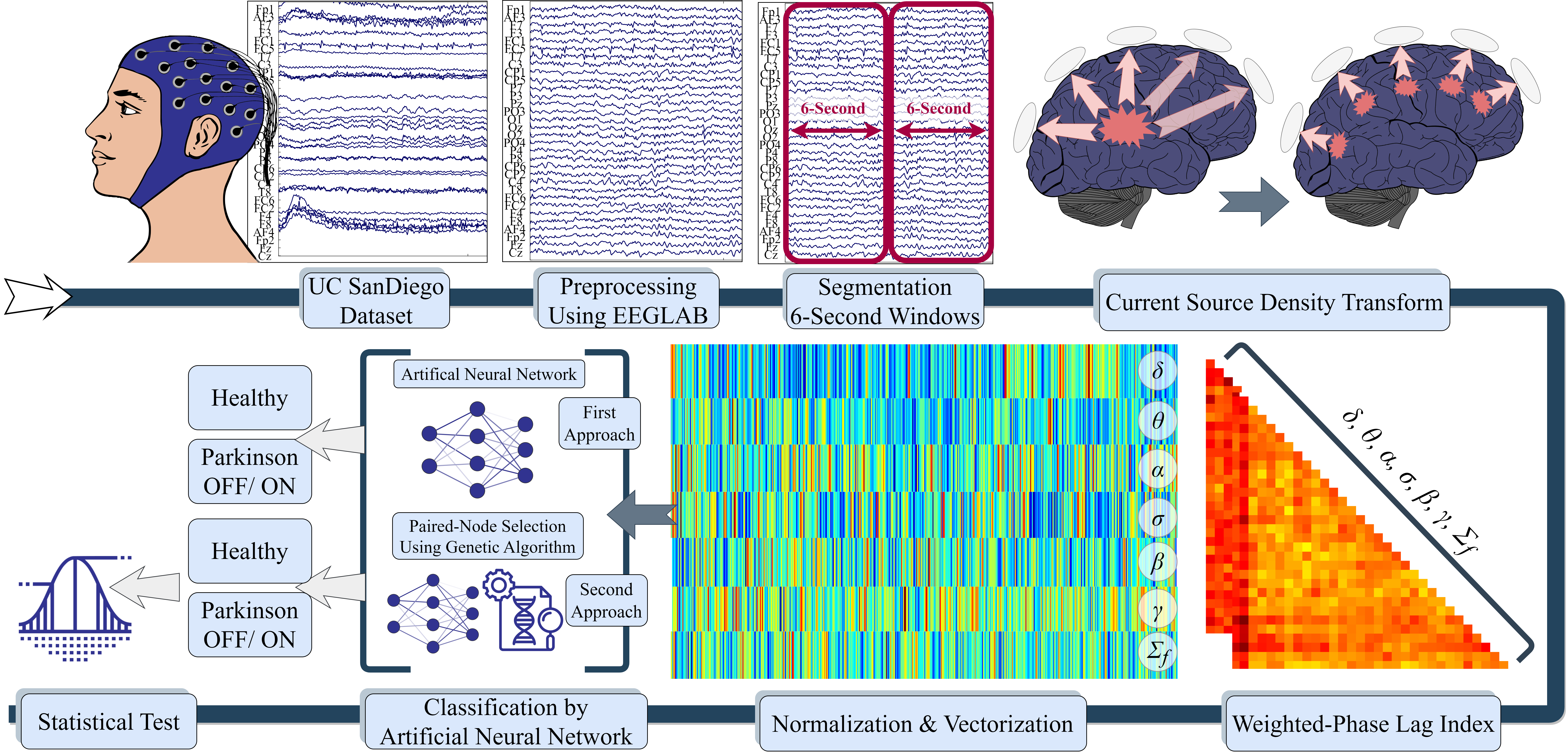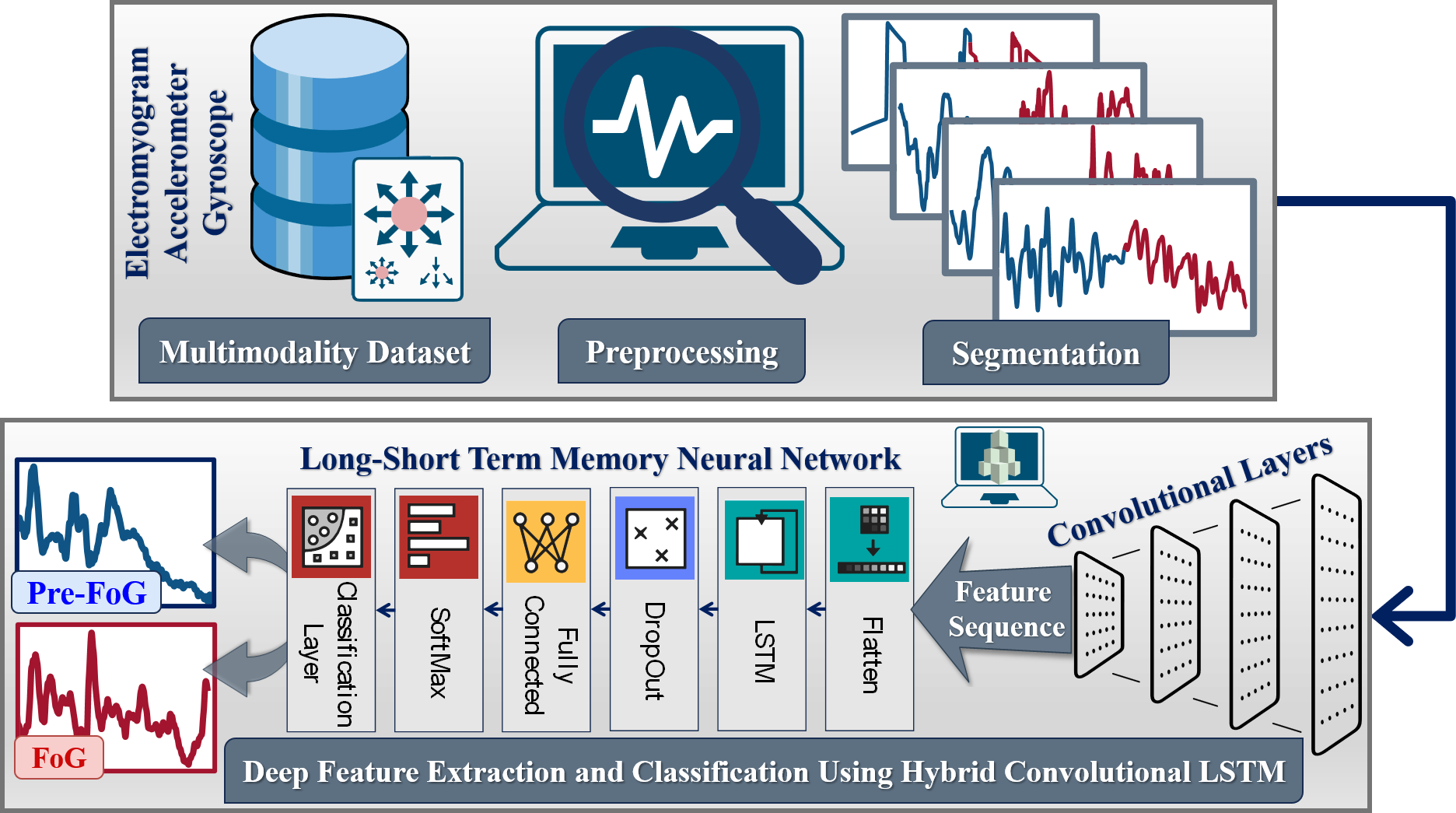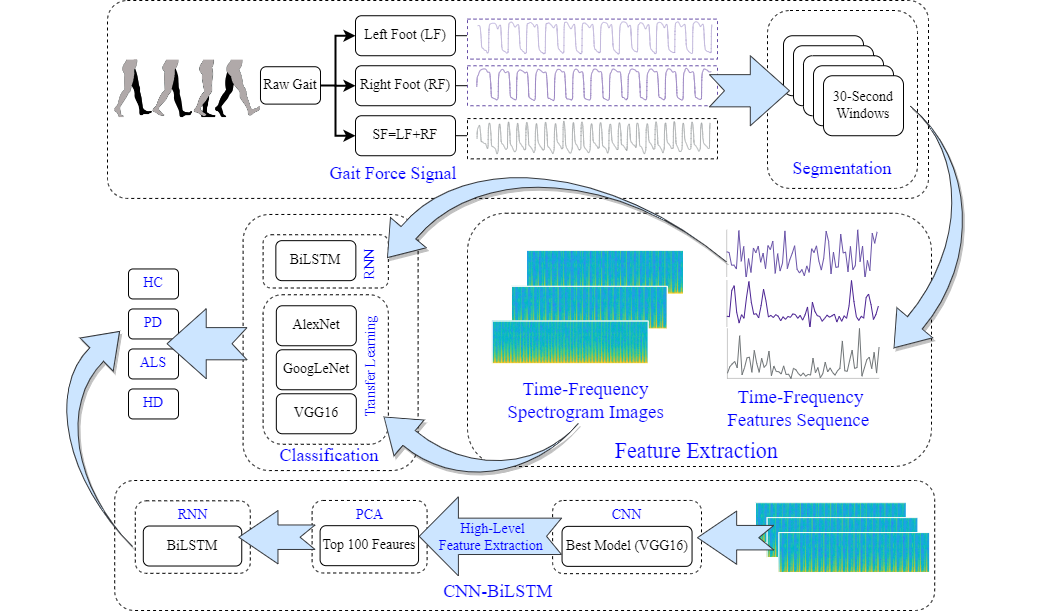Passionate about improving lives through biomedical engineering, I chose this field to fulfill my lifelong desire to help others. As a Senior Biomedical Engineer focusing on programming, I have successfully completed numerous freelance projects over the past three years. My expertise lies in data analysis, image processing, and signal processing, complemented by a deep understanding of programming languages such as Python and MATLAB.
One of my fundamental interests is leveraging programming to develop advanced diagnosis and prediction systems for various diseases. I aim to create innovative solutions to enhance patient care and outcomes by harnessing my data analysis and signal processing skills.
In addition to my technical capabilities, I have a solid technological background and excel in developing computer-aided design systems for biomedical engineering applications. By combining signal processing techniques with machine learning algorithms, I have successfully contributed to advancing this field.
What truly excites me is the realm of Deep Learning. Its potential to revolutionize healthcare and improve patient outcomes is immense. I am constantly driven to expand my knowledge and expertise in this domain, actively seeking further opportunities to develop my skills.
I firmly believe consistency is the key to success throughout my journey. I have achieved significant milestones in my career by maintaining a steadfast approach and consistently delivering high-quality results.
To further enrich my knowledge and acquire new experiences, I am now preparing to embark on a challenging and rewarding endeavor by pursuing a Ph.D. in Biomedical Engineering. This will enable me to delve deeper into research, contribute to cutting-edge advancements, and make a lasting impact.
I am also open to research collaborations and actively looking for collaborators, especially in neuroscience and brain connectivity. Please feel free to contact me.
📝 Publications
Published

Elham Ahmadi Moghadam, Farhad Abedinzadeh Torghabeh, Seyyed Abed Hosseini, Mohammad Hossein Moattar.
-
Attention Deficit Hyperactivity Disorder (ADHD) is a widespread neurobehavioral disorder affecting children and adolescents, requiring early detection for effective treatment. EEG connectivity measures can reveal the interdependencies between EEG recordings, highlighting brain network patterns and functional behavior that improve diagnostic accuracy. This study introduces a novel ADHD diagnostic method by combining linear and nonlinear brain connectivity maps with an attention-based convolutional neural network (Att-CNN). Pearson Correlation Coefficient (PCC) and Phase-Locking Value (PLV) are used to create fused connectivity maps (FCMs) from various EEG frequency subbands, which are then inputted into the Att-CNN. The attention module is strategically placed after the latest convolutional layer in the CNN. The performance of different optimizers (Adam and SGD) and learning rates are assessed. The suggested model obtained 98.88%, 98.41%, 98.19%, and 98.30% for accuracy, precision, recall, and F1 Score, respectively, using the SGD optimizer in the FCM of the theta band with a learning rate of 1e-1. With the use of FCM, Att-CNN, and advanced optimizers, the proposed technique has the potential to produce trustworthy instruments for the early diagnosis of ADHD, greatly enhancing both patient outcomes and diagnostic accuracy.
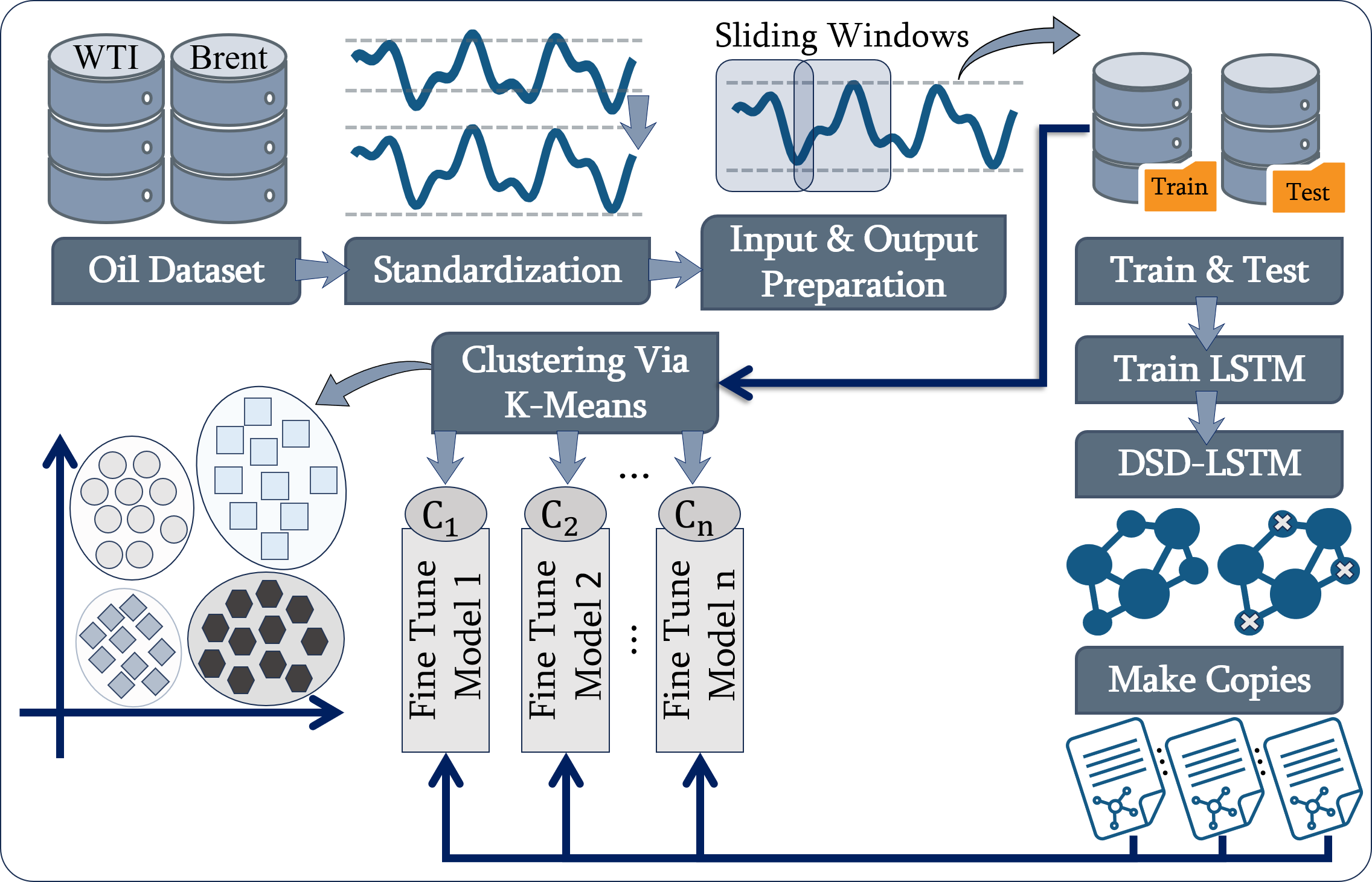
Alireza Jahandoost, Farhad Abedinzadeh Torghabeh, Seyyed Abed Hosseini, Mahboobeh Houshmand*.
-
Crude oil is an essential energy source that affects international trade, transportation, and manufacturing, highlighting its importance to the economy. Its future price prediction affects consumer prices and the energy markets, and it shapes the development of sustainable energy. It is essential for financial planning, economic stability, and investment decisions. However, reaching a reliable future prediction is an open issue because of its high volatility. Furthermore, many state-of-the-art methods utilize signal decomposition techniques, which can lead to increased prediction time. In this paper, a model called K-means-dense-sparse-dense long short-term memory (K-means-DSD-LSTM) is proposed, which has three main training phrases for crude oil price forecasting. In the first phase, the DSD-LSTM model is trained. Afterwards, the training part of the data is clustered using the K-means algorithm. Finally, a copy of the trained DSD-LSTM model is fine-tuned for each obtained cluster. It helps the models predict that cluster better while they are generalizing the whole dataset quite well, which diminishes overfitting. The proposed model is evaluated on two famous crude oil benchmarks: West Texas Intermediate (WTI) and Brent. Empirical evaluations demonstrated the superiority of the DSD-LSTM model over the K-means-LSTM model. Furthermore, the K-means-DSD-LSTM model exhibited even stronger performance. Notably, the proposed method yielded promising results across diverse datasets, achieving competitive performance in comparison to existing methods, even without employing signal decomposition techniques.
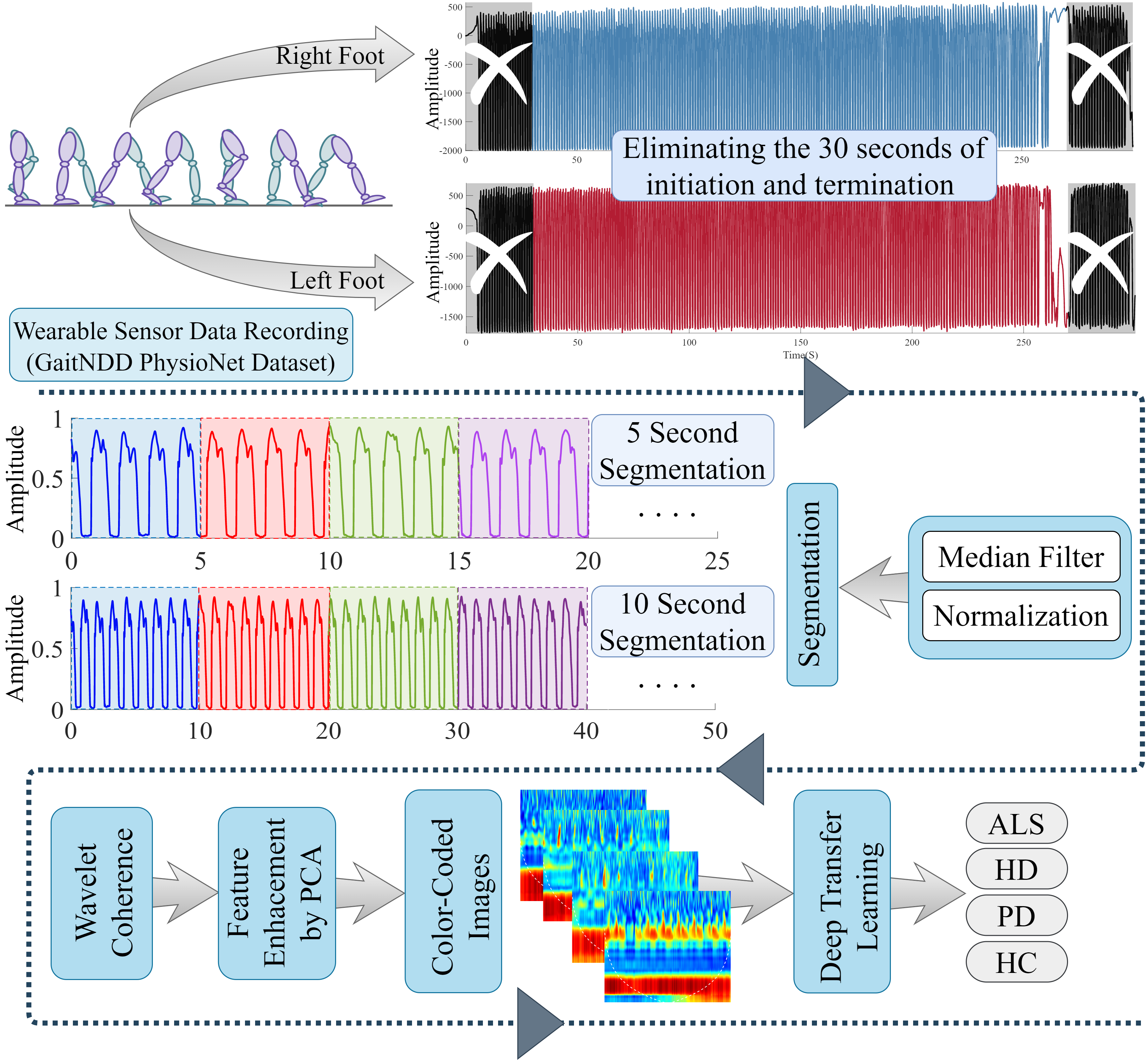
Farhad Abedinzadeh Torghabeh, Elham Ahmadi Moghadam, Seyyed Abed Hosseini*.
-
Neurodegenerative diseases (NDDs) pose significant challenges due to their debilitating nature and limited therapeutic options. Accurate and timely diagnosis is crucial for optimizing patient care and treatment strategies. Gait analysis, utilizing wearable sensors, has shown promise in assessing motor abnormalities associated with NDDs. This study evaluates the extent to which analyzing the interaction of both limbs in the time-frequency domain can serve as a suitable methodology for accurately classifying NDDs. Additionally, it determines the effectiveness of using color-coded images, in conjunction with deep transfer learning models, for the classification of NDDs. The GaitNDD database was used, comprising recordings from patients with Huntington’s disease, amyotrophic lateral sclerosis, Parkinson’s disease, and healthy controls. The gait signals underwent signal preparation, wavelet coherence analysis, and principal component analysis for feature enhancement. Deep transfer learning models (AlexNet, GoogLeNet, SqueezeNet) were employed for classification. Performance metrics, including accuracy, sensitivity, specificity, precision, and F1 score, were evaluated using 5-fold cross-validation. Our results showed that the models' classification performance varied depending on the time window used. For 5-second gait signal segments, AlexNet achieved an accuracy of 95.91%, while GoogLeNet and SqueezeNet achieved 96.49% and 92.73%, respectively. For 10-second segments, AlexNet outperformed other models with an accuracy of 99.20%, while GoogLeNet and SqueezeNet achieved 96.75% and 95.00%, respectively. Statistical tests confirmed the significance of the extracted features, indicating their discriminative power for classification. The proposed method demonstrated superior performance compared to previous studies, offering a non-invasive and cost-effective approach for the automated diagnosis of NDDs. By analyzing the interaction between both legs during walking using wavelet coherence and utilizing deep transfer learning models, accurate classification of NDDs was achieved.
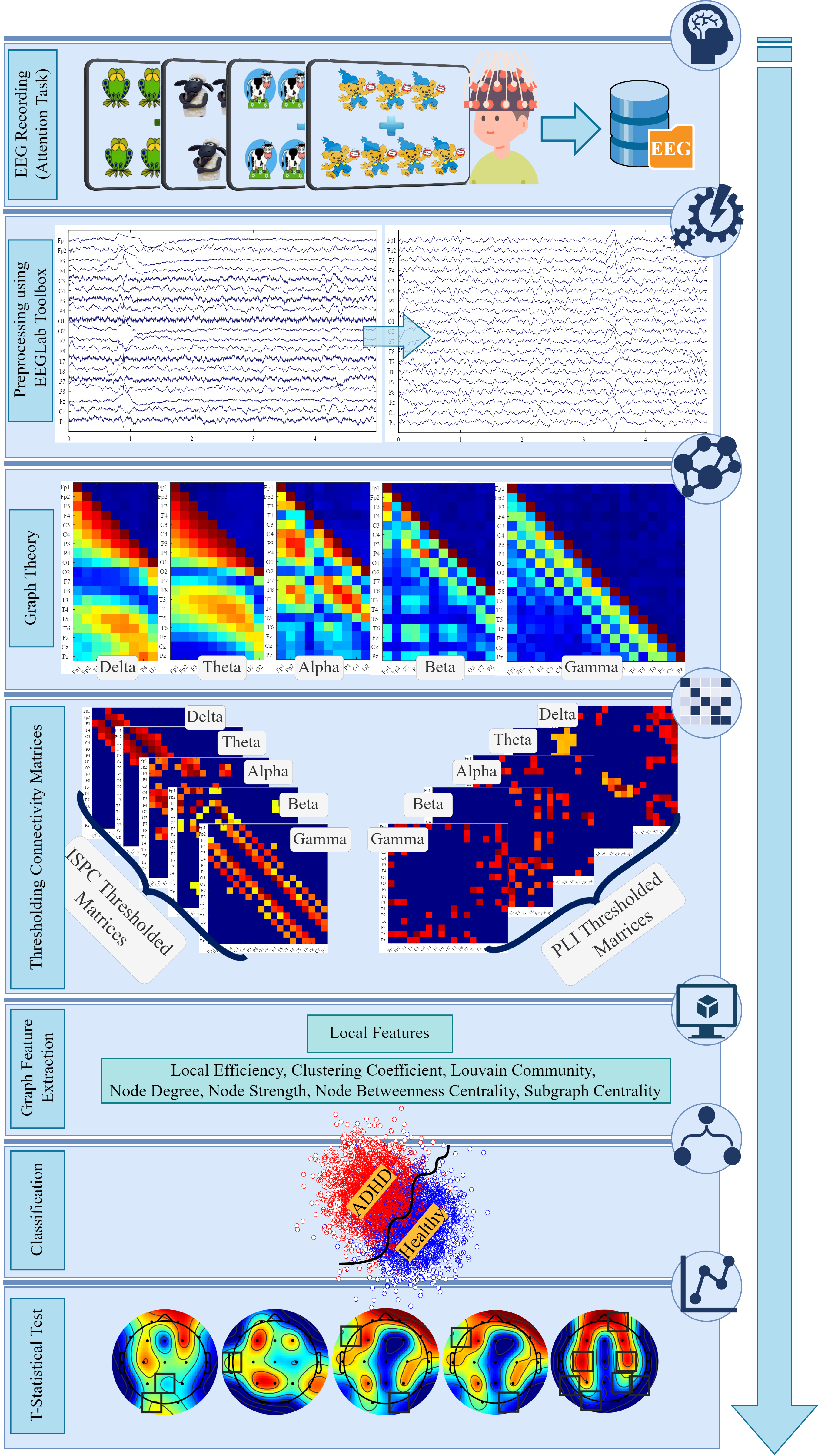
Farhad Abedinzadeh Torghabeh, Seyyed Abed Hosseini*, Yeganeh Modaresnia.
-
This research investigates an efficient strategy for early detection and intervention of attention-deficit hyperactivity disorder (ADHD) in children. ADHD is a neurodevelopmental condition characterized by inattention and hyperactivity/impulsivity symptoms, which can significantly impact a child’s daily life. This study employed two distinct brain functional connectivity measurements to assess our approach across various local graph features. Six common classifiers are employed to distinguish between children with ADHD and healthy control. Based on the phase-based analysis, the study proposes two biomarkers that differentiate children with ADHD from healthy control, with a remarkable accuracy of 99.174%. Our findings suggest that subgraph centrality of phase-lag index brain connectivity within the beta and delta frequency bands could be a promising biomarker for ADHD diagnosis. Additionally, we identify node betweenness centrality of inter-site phase clustering connectivity within the delta and theta bands as another potential biomarker that warrants further exploration. These biomarkers were validated using a t-statistical test and yielded a p-value of under 0.05, which approved their significant difference in these two groups. Suggested biomarkers have the potential to improve the accuracy of ADHD diagnosis and could help identify effective intervention strategies for children with the condition.
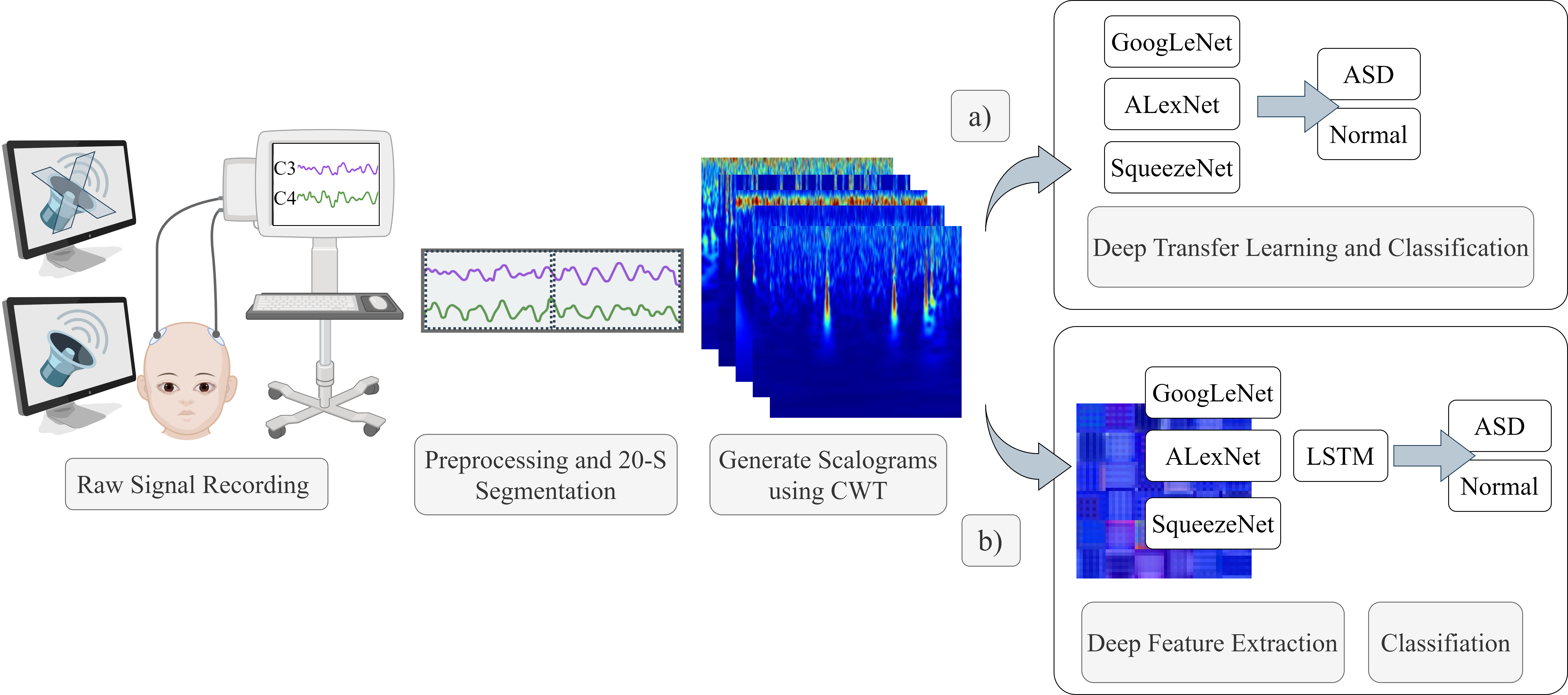
Farhad Abedinzadeh Torghabeh, Yeganeh Modaresnia, Mohammad Hossein Moattar*.
-
Early diagnosis of autism spectrum disorder (ASD) plays an important role in the rehabilitation of the patient. This goal necessitates higher-level pattern representation and a strong modeling approach. The proposed approach applies scalogram images of electroencephalography signals for the first purpose and a two-level deep learning architecture for better classification. Scalogram images embed both the temporal and spectral information of the signal. On the other hand, the hybrid deep learning hierarchy of convolutional neural network followed by long short-term memory models both spatial and temporal information of the scalogram image. The approach is evaluated on a dataset of 34 ASD samples and 11 normal cases in without-voice and with-voice conditions. To validate the early diagnosis hypothesis, signals from children older than 5 years are used as the training set, and signals from younger subjects are used as the validation set. The proposed method achieves excellent performance of 99.50% and 98.43% for automatically detecting ASD with and without voice, respectively. This classification performance is higher than most recent reported approaches, and the results show the effectiveness of the approach in early diagnosis of ASD and demonstrate the auditory impact on the diagnosis of autism.
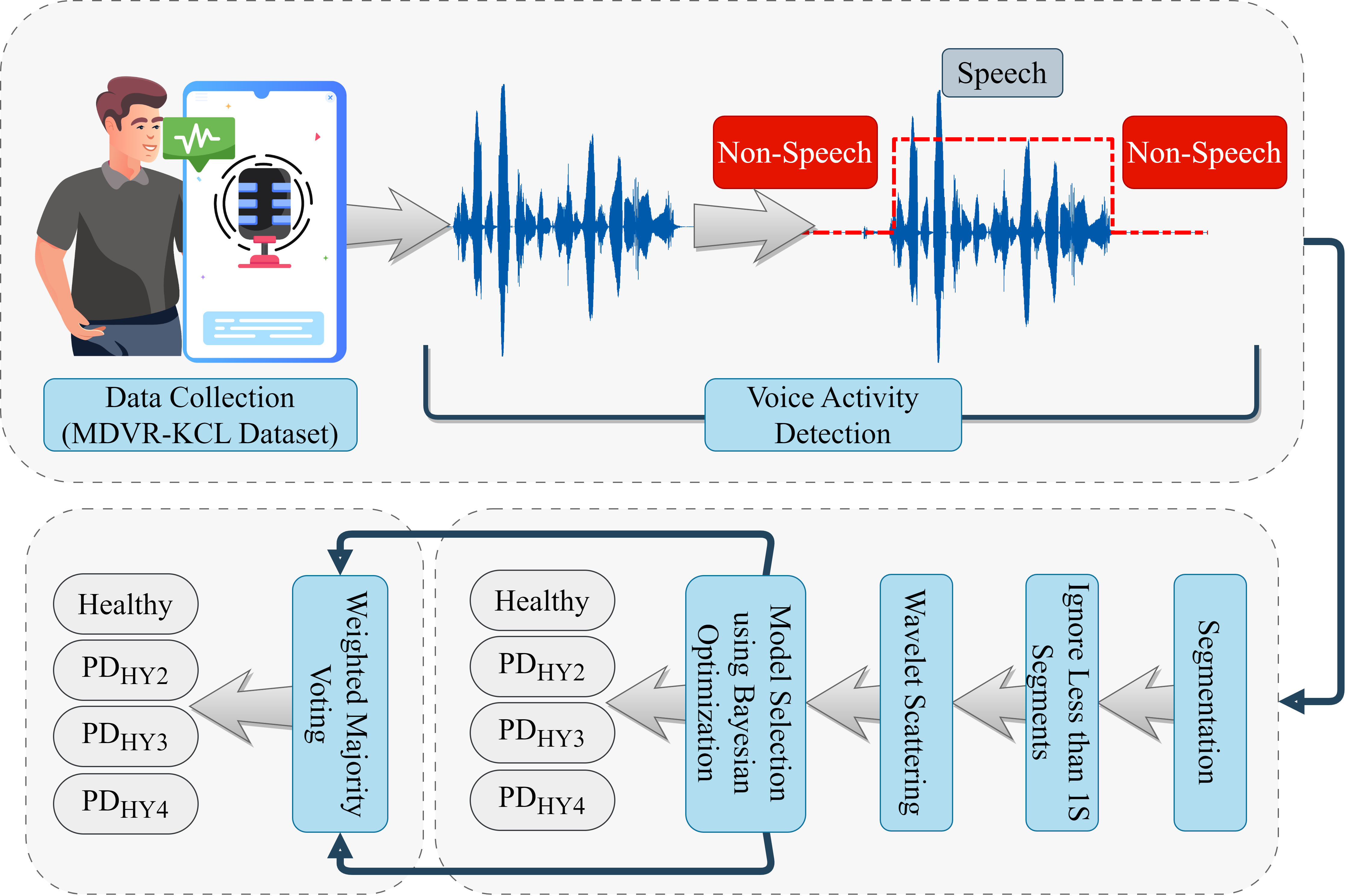
Farhad Abedinzadeh Torghabeh, Seyyed Abed Hosseini*, Elham Ahmadi Moghadam.
-
Parkinson's disease (PD) is a neurodegenerative disorder characterized by motor and non-motor symptoms that significantly impact an individual's quality of life. Voice changes have shown promise as early indicators of PD, making voice analysis a valuable tool for early detection and intervention. This study aims to assess and detect the severity of PD through voice analysis using the mobile device voice recordings dataset. The dataset consisted of recordings from PD patients at different stages of the disease and healthy control subjects. A novel approach was employed, incorporating a voice activity detection algorithm for speech segmentation and the wavelet scattering transform for feature extraction. A Bayesian optimization technique is used to fine-tune the hyperparameters of seven commonly used classifiers and optimize the performance of machine learning classifiers for PD severity detection. AdaBoost and K-nearest neighbor consistently demonstrated superior performance across various evaluation metrics among the classifiers. Furthermore, a weighted majority voting (WMV) technique is implemented, leveraging the predictions of multiple models to achieve a near-perfect accuracy of 98.62%, improving classification accuracy. The results highlight the promising potential of voice analysis in PD diagnosis and monitoring. Integrating advanced signal processing techniques and machine learning models provides reliable and accessible tools for PD assessment, facilitating early intervention and improving patient outcomes. This study contributes to the field by demonstrating the effectiveness of the proposed methodology and the significant role of WMV in enhancing classification accuracy for PD severity detection.
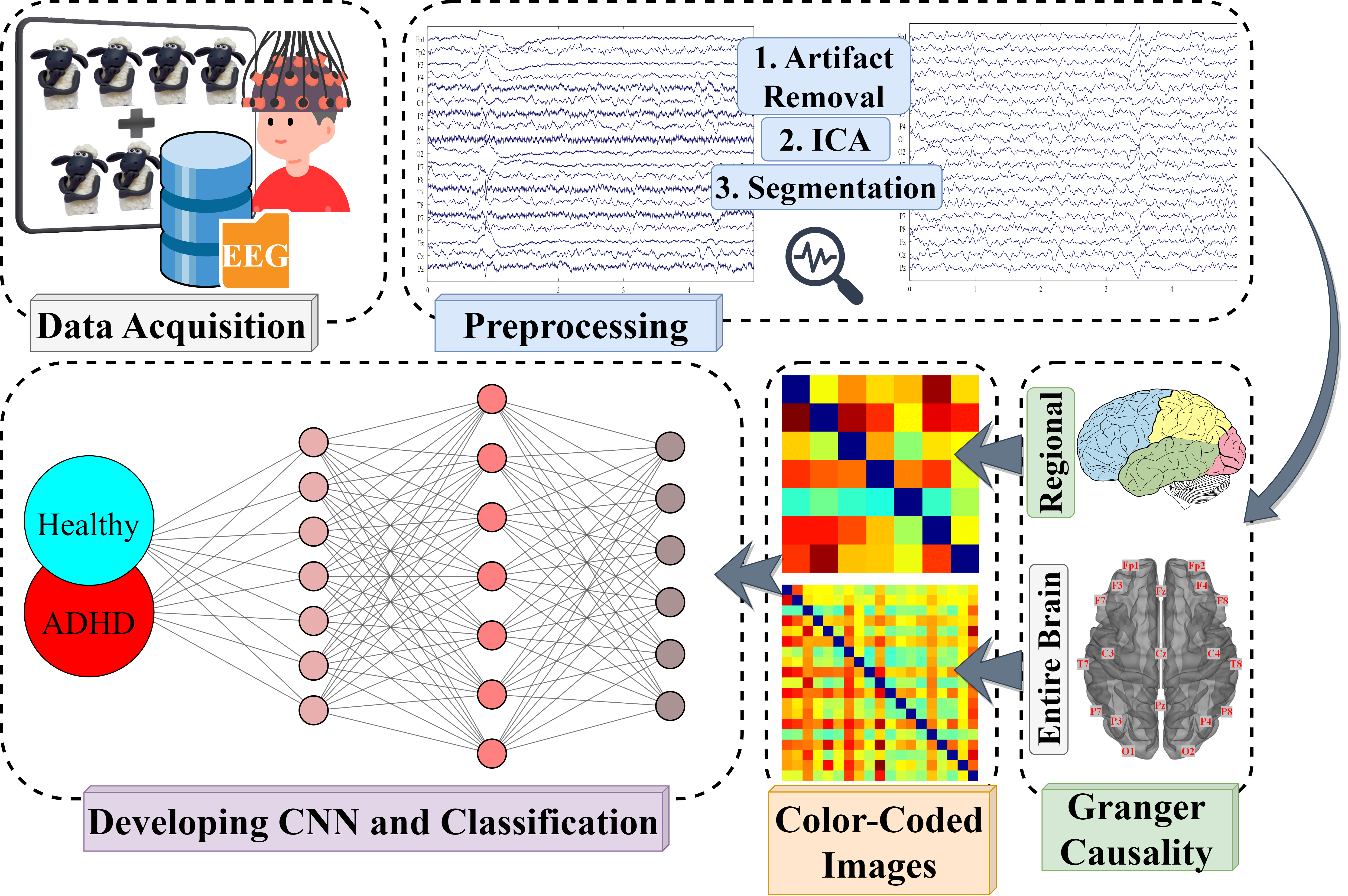
Farhad Abedinzadeh Torghabeh, Yeganeh Modaresnia, Seyyed Abed Hosseini*.
-
Attention deficit hyperactivity disorder (ADHD) is prevalent worldwide, affecting approximately 8-12% of children. Early detection and effective treatment of ADHD are crucial for improving academic, social, and emotional outcomes. Despite numerous studies on ADHD detection, existing models still lack accuracy distinguishing between ADHD and healthy control (HC) children. This study introduces an innovative methodology that utilizes granger causality (GC), a well-established brain connectivity analysis technique, to reduce the required EEG electrodes. We computed GC indexes (GCI) for the entire brain and specific brain regions, known as regional GCI, across different frequency bands. Subsequently, these GCIs were transformed into color-coded images and fed into a custom-developed 11-layer convolutional neural network. The proposed model is evaluated through a five-fold cross-validation, achieving the highest accuracy of 99.80% in the gamma frequency band for the entire brain and an accuracy of 98.50% in distinguishing the theta frequency band of the right hemisphere of ADHD and HC children by only using eight electrodes. The proposed framework provides a powerful automated tool for accurately classifying ADHD and HC children. The study’s outcome demonstrates that the innovative proposed methodology utilizing GCI and a custom-developed convolutional neural network can significantly improve ADHD detection accuracy, improving affected children’s overall quality of life.

Yeganeh Modaresnia, Farhad Abedinzadeh Torghabeh, Seyyed Abed Hosseini*.
-
Diabetes retinopathy (DR) is the primary cause of blindness worldwide. Computer-aided diagnosis methods for early detection of DR fundus images are time and effort-saving and have a low risk of a misdiagnosis compared with a manual diagnosis of DR by clinical experts and ophthalmologists. Recently, transfer learning strategies of pre-trained models have been increasingly employed in medical image detection as a deep learning technique, and they effectively speed up the training phase. However, the effect of image enhancement and hyper-parameter tuning in DR detection was not reported in the literature. Furthermore, conventional transfer learning strategies, while widely employed, have exhibited limitations in achieving high accuracies in this context. Here, we employed the publicly available APTOS dataset for training models. Three different image enhancement techniques, including contrast enhancement, color constancy, and contrast-limited adaptive histogram equalization (CLAHE), are used on DR and its severity detection. Bayesian optimization method was employed for hyper-parameter tuning. Three different pre-trained convolutional neural networks, namely AlexNet, GoogLeNet, and SqueezeNet, are investigated on the binary and multi-classification of DR fundus images. The AlexNet model with tuned training hyper-parameters showed an accuracy of 99.10% for multi-classification of DR. The modified AlexNet + genetic algorithm and tuned hyper-parameters model achieved an impressive accuracy of 99.81% in the same multi-level classification of DR severity. The CLAHE enhancement technique outperforms other techniques in these approaches. The reliable performance of the proposed method would enhance the rapid and robust detection of DR utilizing fundus images to intervene effectively before vision loss occurs.

Farhad Abedinzadeh Torghabeh, Yeganeh Modaresnia, Seyyed Abed Hosseini*.
-
Parkinson's disease (PD) is a widespread neurodegenerative condition that affects many individuals annually. Early identification and monitoring of disease progression are crucial to effectively managing symptoms and preventing motor complications. This research proposes an automated PD diagnosis and severity-grading model based on time-frequency and fuzzy features using improved uni-directional and bi-directional long short-term memory networks with sensitive hyperparameters optimization. We utilize vertical ground reaction force signals collected from Physionet's publicly available dataset recorded during regular and dual-task clinical trials of walking measurements. Only the cumulative signal of both feet was then utilized and segmented into 30-s windows without further pre-processing. Subsequently, we extracted only four key time-frequency and fuzzy features from each segment, effectively capturing the signal's inherent uncertainty. Bayesian optimization is employed in both detection and grading approaches to fine-tune the two critical hyperparameters: the initial learning rate and the number of hidden units in the network. The detection phase yields an exceptional accuracy of 99.19%, surpassing state-of-the-art studies with the same dataset. In the grading phase, classification based on the unified PD rating scale values achieves an accuracy of 92.28%. The proposed study delves into the potential of cumulative gait signals as a powerful diagnostic tool for PD, aiming to extract precise and intricate information by implementing straightforward and minimal processing endeavors. This method demonstrates significant efficiency in terms of complexity, cost, and energy consumption by utilizing a single-dimensional signal, eliminating the need for pre-processing steps, and limiting the features used for training.
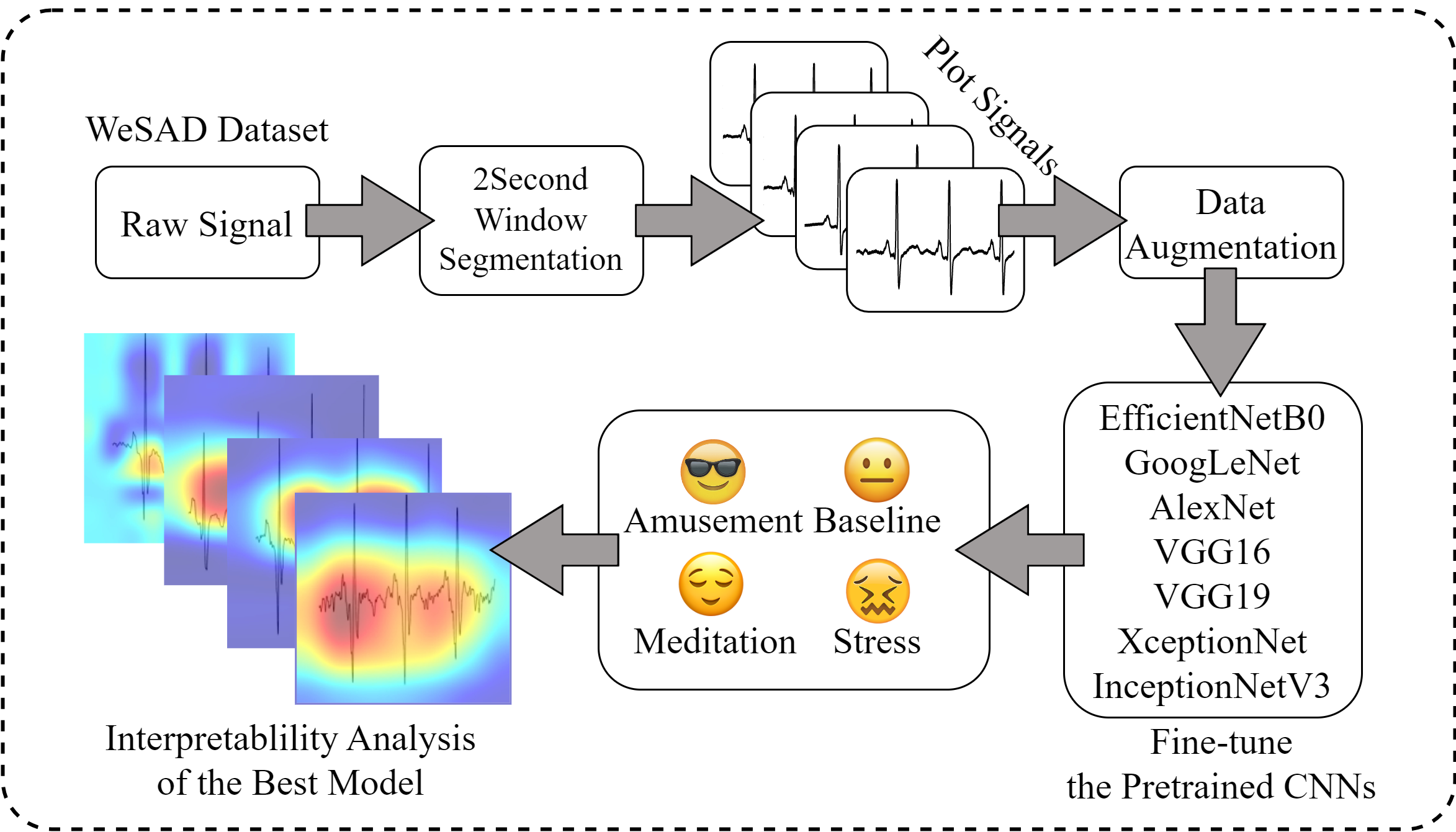
A Pre-Processing Free Mental State Detection Model Suitable for Real-Time Applications
Farhad Abedinzadeh Torghabeh, Yeganeh Modaresnia, Seyyed Abed Hosseini*.
-
The biomedical field plays a pivotal role in advancing healthcare by leveraging technological innovations to enhance diagnostics and treatment strategies. In the context of neurological disorders, particularly epilepsy, automated EEG signal processing stands out as a critical facet of biomedical research. The ability to analyze and interpret vast amounts of electroencephalogram (EEG) data using sophisticated techniques, such as continuous wavelet transform, contributes significantly to the timely and accurate detection of epileptic events. Automated EEG signal processing, which uses advanced algorithms and pattern recognition methods, enables the identification of subtle yet crucial patterns indicative of epileptic activity. This paper presents an in-depth exploration of epilepsy identification using the CWT on the CHB-MIT Scalp EEG database. The study uses nine complex mother wavelets from the Gaussian and Morlet families to look at 8920 EEG segments, including 197 seizure events. The performance of each wavelet in detecting epileptic convulsions within EEG signals is rigorously evaluated. Our study shows that the complex Gaussian wavelet of order 5 (cgau5) emerged as the optimal choice, with a sensitivity of 97.58% and a precision of 97.93%. To improve epilepsy detection, we introduce burst energy, a novel engineered feature. This method gets accurate information about brain activity from the CWT scalogram by detecting ictal and ictal-free EEGs at different energy levels. The use of burst energy has a significant impact on classification performance, highlighting its potential for improved accuracy in epilepsy identification. This comprehensive study contributes valuable insights into selecting appropriate wavelets and introduces an innovative feature for more effective EEG-based epilepsy detection.
Journal of Biomedical Engineering: Applications, Basis and Communications. 2024Effectiveness of Learning Rate in Dementia Severity Prediction Using VGG16, Farhad Abedinzadeh Torghabeh, Yeganeh Modaresnia, Mohammad Mahdi Khalilzadeh*.13th International Conference on Computer and Knowledge Engineering (ICCKE). 2023An Efficient Approach for Breast Abnormality Detection through High-Level features of Thermography Images, Farhad Abedinzadeh Torghabeh, Yeganeh Modaresnia, Seyyed Abed Hosseini*.13th International Conference on Computer and Knowledge Engineering (ICCKE). 2023EfficientNetB0’s Hybrid Approach for Brain Tumor Classification from MRI Images Using Deep Learning and Bagging Trees, Yeganeh Modaresnia, Farhad Abedinzadeh Torghabeh, Seyyed Abed Hosseini*.Iranian Journal of Medical Physics. 2023Deep Learning-Based Brain Tumor Segmentation in MRI Images: A MobileNetV2-DeepLabv3+ Approach, Farhad Abedinzadeh Torghabeh, Seyyed Abed Hosseini*.
Under Review
📖 Education
- Jan 2021 - Aug 2023, MS in Biomedical Engineering (Sports Engineering), Mashhad Branch, Islamic Azad University, Mashhad, Iran.
- Sep 2015 - Sep 2020, BS in Biomedical Engineering, Sadjad University of Technology, Mashhad, Iran.
💻 Professional and Academic Experience
Venture Capital Analyst of Medical Devices
- Feb 2024 - Now, Venture Capital Analyst of Medical Devices at Razavi HighTech Industries.
Instructor
- May 2024, Workshop of EEG Signal Processing, held by National Brain Mapping Laboratory. Ferdowsi University of Mashhad, Mashhad, Iran.
- Jul 2022 - Oct 2022, A Project-Oriented Course of Biomedical Image & Signal Processing Using MATLAB. Mashhad Branch, Islamic Azad University, Mashhad, Iran.
Research Assistant
- Oct 2021 - Now, Under Assoc.Prof.Seyyed Abed Hosseini at the Islamic Azad University, Mashhad, Iran.
- Currently Working Several Research Projects, Including “Analysing Brain Connectivity Using Multimodality Data on Various Neurological Diseases”.
Academic Peer Reviewer
- Jan 2024 - Now, Journal of Physical and Engineering Sciences in Medicine, Springer.
- Sep 2023 - Now, Journal of Computers in Biology and Medicine, Elsevier.
- Jun 2023 - Now, Journal of Pattern Recognition Letters, Elsevier.
- Feb 2023 - Now, Journal of Biomedical Signal Processing and Control, Elsevier.
Freelance Programmer | On-site, Remote and Hybrid
- Jan 2022 - Now, Freelance Programmer (Python & MATLAB) and Research Supervisor.
🏆 Honors and Awards
- Ranked 2nd among All Master Students of Biomedical Engineering, Department of Biomedical Engineering, Mashhad Branch, Islamic Azad University, Mashhad, Iran.
- Selected as a Finalist Among 100 Teams by Introducing the Concept of an Intelligent Ring for Epileptic Seizure Prediction using HRV Signal, One Thousand Technological Ideas Tournament, Islamic Azad University of Mashhad, Mashhad, Iran.
- Member of Biomedical Engineering Scientific Association, Department of Biomedical Engineering, Mashhad Branch, Islamic Azad University, Mashhad, Iran.


